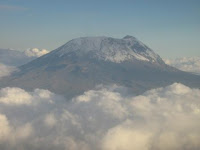I was employed to carry out an inspection and report on an industrial operation in China, the details of which while interesting have nothing to do with eating - which is the subject of this account.
The first meal in mainland China was a
magnificent spread served in a private lounge in a swank spa hotel. A salon privet without any allusions to
gambling (unusual in a nation of reportedly inveterate gamblers). Very
civilised, a room with a couple of couches and a low table from which one can delicately sip Chinese tea.
The Dining table was circular with a very large Lazy Susan dominating the centre. Our hosts were most attentive and signalled
to the perpetually hovering waitron that I should be furnished with an EPNS knife
and fork set – a kind gesture that I huffily rejected. Stick to the chop
sticks my inner arrogant self declared – which was more than the damned food would
do to the blasted implements.
It was a familiar Chinese dining affair with a steady
and measured stream of dishes ranging from fish stuff to poultry stuff, baby
succulent shrimps, sweet potatoes, and nigh-on inedible spinach. This latter green muck had been heavily steamed but still retained an eerie and ghastly luminescent hue.
It’s like eating a vegetable that truly does not want to be eaten and is
holding a grudge against anyone foolish enough to attempt to. Needless to say
capturing the stuff with chop sticks is a mission in itself. The soup however
was delish and divine!
As we slurped away – and you can only slurp
out of the cute and entirely un-ergonomic porcelain spoons provided – the
faithful George turned to me with a face suffused with pure ecstasy and making expansive lip-smacking noises said something complimentary about the soup. I had
to agree that it was jolly nice. “Sharks fin” he extolled, and it was still
jolly nice even knowing what it was. And after all as a salve to my green
conscience I did not go out and kill the fish, nor did I order it, nor did I know that it had been ordered. At another restaurant
in Hong Kong a couple of days later I came
across sharks fin soup on the menu at the astonishing price of HK$2,600 for a
bowl.
 |
|
Cabernet Sauvignon . .” The wealthy Mr. Wu sits on
Mr. Cs’ right and the
studious George is on
my left. The delectable Belinda is guarding our backs.
|
____________________________________________________________________
Lunch the next day was taken at a very busy
restaurant in Fogang that had a frantic valet service in the car park. The generous Mr Wu is
plainly very well known in this milieu.
The foyer has a large display area of live aquatic wildlife. Here you can view
your menu in the flesh. Quite whether you identify your chosen escargot with an indelible magic marker as you pass by I don’t know.
There was a very large tank of Koi, which are giant goldfish with psychedelic colouring and attitude to match. The type of fish the Japanese
seem to venerate and misguided Westerners spend thousands of dollars on
purchasing, breeding and “showing”. The Chinese are far less aesthetically
bound - they just eat them. Also on view was a particularly luscious looking slab of freshly
slaughtered crocodile complete with craggy skin.
We were swept past these temptations into
another salon privet; with a similar array of
couches, circular table, Lazy Susan (this time electrically powered), and wide flat
screen TV showing truly dire soaps with a Cantonese soundtrack and subtitles in Chinese
(why?). This room had its own outside squat-pan privy accessed
via a windy path through a very pretty formal outside walled garden.
Mr Wu made a comprehensive and complicated order for the seven of us. Gosh this guy’s got money - but what is on the menu?
Mr Wu made a comprehensive and complicated order for the seven of us. Gosh this guy’s got money - but what is on the menu?


+of+05_03_2010+136.jpg)














+of+05_03_2010+134.jpg)












